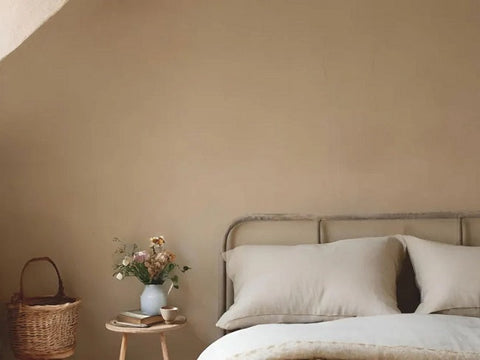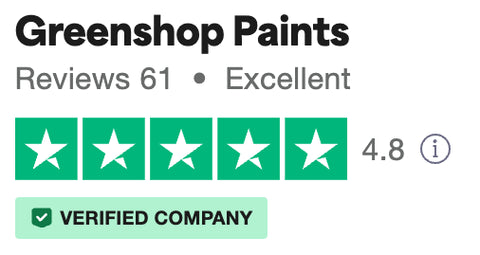Limewash is a traditional paint finish that’s been in use for centuries. Many period properties in the UK would have had limewash paint finishes on interiors and exteriors. If you’re renovating a heritage home, you may consider using a traditional limewash to stay true to the history and fabric of your building. But how does an authentic limewash paint finish fit with modern life and expectations?
In this guide, we’ll explore what limewash is, where it works best, and why many homeowners today are opting for alternatives that offer similar breathability and better durability.

Pictured: Graphenstone Exterior, a modern lime and silicate based breathable paint suitable for older homes. Colour: Sienna.
What is Limewash Paint?
Limewash is a traditional paint finish made from slaked lime (Calcium Hydroxide) mixed with water. Unlike modern paints, it penetrates into the surface rather than forming a film on top, creating a natural bond with lime plaster, stone, or brick. As it cures, limewash undergoes carbonation, a chemical reaction with carbon dioxide in the air which hardens the finish and gives it its characteristic matte, chalky look.
Limewash is a highly breathable paint, making it a suitable and authentic choice for old houses with solid walls.
It’s been used for centuries throughout Europe, and if you’ve seen the ruins of a limekiln in the British countryside, you’ve seen part of the history of how this paint type was made.
Ancient Limewash Manufacturing Processes
Lime kilns were used to create quick lime. First limestone was crushed, and placed in a kiln where it was burned at high temperatures for three days.
Traditional manufacturing processes were very fuel inefficient, half a tonne of coal was needed to create a tonne of finished lime. Fortunately modern lime paint production methods are much more efficient, and companies including Graphenstone Paints carbon offset their manufacturing processes.
The lime was used for many purposes including making limewash, mortar, and agricultural use. To create paint, the lime (quicklime) from the kiln was mixed with water to create a lime putty. Mixing quicklime and water creates a chemical reaction known as slaking. The reaction takes a minimum of several months to complete, ensuring the finished product is stable. In Roman times, the putty was matured for a minimum of three years.
Modern limewash production methods are broadly true to the ancient roots of this paint type, but that means its performance is not comparable to more refined modern paints. It’s important to understand the characteristics of limewash when deciding if it’s the right product for repainting the interior or exterior surfaces of your old home.
Traditional vs Modern Limewash
Traditionally, limewash was mixed and slaked, requiring ageing before use. It was temperamental, requiring numerous thin coats (typically 4 to 6) and constant reapplication. Colour consistency was hard to achieve, and the final result depended heavily on how it dried.
Modern limewash products are usually sold premixed, and coloured tints are available, improving consistency and ease of use. However, they retain many of the original drawbacks: they’re still highly sensitive to humidity, offer minimal scrub resistance, and can require full wall repaints if areas of damage need to be touched up. Even modern limewash requires multiple coats on an unpainted wall, it can be as many as 4. It will then need a fresh coat applied every 5-7 years to ensure a durable finish.
Pros of Limewash
The appeal of limewash lies in its natural character:
High breathability: Limewash allows moisture to escape from solid walls, helping prevent trapped damp. It’s ideal for lime plaster and masonry in heritage buildings. It offers natural mould and mildew resistance.
Sustainability: Made from lime and water, limewash is free from solvents, plastics and synthetic binders. It contains no VOCs and is biodegradable.
Soft aesthetic: Its subtle colour variations and matte texture create a distinctive, light diffusing finish that evolves beautifully over time. It provides a soft and rustic finish.
Cons of Limewash
Despite its beauty, limewash is not without limitations. The paints simple formulation affects it’s performance which can cause issues.
Low durability: Limewash can rub off with contact and is not scrub-resistant. This makes it poorly suited to busy hallways, kitchens, or anywhere prone to scuffs.
Difficult to repair: You can’t spot-repair limewash. If a patch flakes or marks, the whole wall often needs repainting to blend the finish.
Limited substrate compatibility: Limewash performs best on bare, porous materials like lime plaster, stone, and brick. It does not adhere well to modern gypsum plaster or painted surfaces without extensive preparation.
Labour intensive application: Limewash requires careful surface prep, misting, and usually several thin coats. It must be applied while keeping a wet edge and can’t be paused mid wall.
How to Apply Limewash
Applying limewash requires care and a proper application technique:
Prepare the surface by ensuring it's clean, dust-free, and slightly damp. For best results, prime very porous surfaces with limewater.
Use a wide, soft brush to apply in a cross-hatch pattern, maintaining a wet edge. Avoid rollers or spraying unless you're very experienced.
Build up thin coats, allowing each to carbonate and dry slowly.
Mist between coats and ensure good ventilation. Rapid drying can cause crazing or powdery results.
Never stop mid-wall or touch up dry areas — this results in visible lines or colour differences.
Modern Lime Based Paints - Better Alternatives for Most Homes
Given these constraints, many renovators now opt for modern lime based paints that offer a similar appearance but with better performance and durability.
Delivers a similar ultra matt, mineral finish to limewash, with a soft, feel and typical lime character. It is highly breathable making it perfect for older, historic buildings. Easier to apply and higher durability than limewash.
Suitable For: Interior Walls
Auro 344 Lime Paint - White & Lime Based
A true lime-based formulation that provides high breathability (SD value < 0.05 m) and exceptional opacity compared to traditional limewash. Its ease of use and superior coverage make it an excellent choice for those seeking authentic lime performance without the mess and unpredictability of limewash.
Suitable For: Interior & Exterior Walls & Ceilings
Graphenstone GCS - Wide Range of Colours & High Performance
A modern lime paint offering 24 heritage colours. Suitable for both interior and exterior walls, it adheres well to mineral surfaces such as plaster, render, brick, and gypsum. This paint delivers a durable matt finish.
Suitable For: Interior & Exterior Walls
Graphenstone Ambient Pro - Premium White & Off White Finish
Provides an ultra matt, mineral finish enhanced with photocatalytic technology, which helps break down airborne pollutants and improve indoor air quality. Ambient Pro gives a soft, elegant finish with long lasting performance.
Suitable For: Interior Walls & Ceilings
Dealing with damp or mould?
For Damp & Mould - Auro 327 & Auro 303 are specially formulated for high-humidity and moisture-prone areas. Both offer natural mould resistance thanks to high alkalinity. This paint dries with a classic matt finish. It’s a dependable choice for bathrooms, kitchens, or anywhere condensation is a concern.
Also consider for a traditional mineral finish:
Lime Earth Paint – A pigmented lime-based paint made using traditional methods. It offers a similar breathable, mineral character to limewash but with better coverage, colour options, and ease of use. This paint still requires a whole wall application to avoid visible joins, and clay and lime plasters need to be moistened before application. A great fit for listed buildings or interiors with a soft, earthy aesthetic.
Suitable For: Interior & Exterior Walls
Further reading: Best paint for lime plaster
FAQs
Can I limewash over modern paint or wallpaper? No. It won’t adhere properly or breathe. Remove paint or wallpaper before applying.
Is limewash suitable for bathrooms? Generally not. It's not water-repellent and may fail in splash zones or where condensation builds up. Use Auro 327 or 303 instead.
Limewash - A Beautiful Past but Better Options Today
Limewash has a timeless beauty and is perfect for certain heritage settings, but it’s not always the best modern solution. With today’s breathable, low VOC paints, you can get the same aesthetic benefits with better durability, easier maintenance, and broader surface compatibility.
Further Reading: Breathable paint for old houses | Heritage paints for period properties & listed buildings





